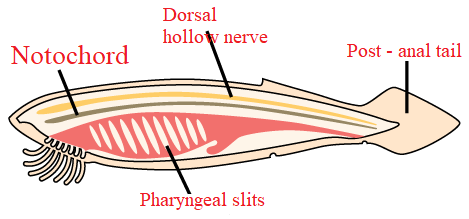
What are the four main characteristics of chordates?
Answer
495.3k+ views
Hint: Chordates are classification of animal kingdom. The main classification or characteristic feature of chordates is the presence of notochord. Chordates belong to the phylum Chordata. The differences between the phylum Chordates and Non-chordates are - the presence and absence of notochord. This is the most remarkable difference. In Chordates notochord is present and in non-chordates notochord is absent.
Complete Explanation:
The four main characteristics of chordates are- a notochord, a dorsal hollow nerve cord and pharyngeal gill slits in pair and also a post anal tail. Chordates are bilaterally symmetrical, triploblastic, coelomate. They have an organ system level of organization. They have a closed circulatory system. Their central nervous system is dorsal, hollow and single. Pharynx are perforated by gill slits. Heart is present ventrally in the body.
Phylum Chordata is divided into three subphylums that are- Urochordata, Cephalochordates and Vertebrates. Urochordata and Cephalochordates are said to be marine. The notochord is exclusively found in the larval tail of Urochordata. In Cephalochordates the notochord extends from head to tail region and the notochord remains throughout their life.
Examples of Urochordates are Ascidia, Salpa and Cephalochordates are Amphioxus.
The presence of a notochord defines the subphylum Vertebrata. Notochord is present only at the embryonic stage of these animals. Later they are modified or replaced by spinal cord also known as vertebral columns. Hence, all vertebrates can be called as chordates but all chordates cannot be defined as vertebrates. Vertebrates have a ventral muscular heart with four chambers, kidneys for excretion and they possess osmoregulation and paired appendages which can be fins or limbs.

Note:
As we discussed the main characteristics. Let us know about some more examples. Amphibians like- toads, frogs, salamanders fall under class amphibia. Class- Reptilia includes creepy crawly animals which possess crawling and creeping mode for their locomotion. They are mostly terrestrial animals. Except crocodiles’ rest all have four- chambered hearts. Examples- Turtle, Tortoise, tree lizard, poisonous snakes, alligator. Also, classes like- Aves, Mammalia also considered as chordates.
Complete Explanation:
The four main characteristics of chordates are- a notochord, a dorsal hollow nerve cord and pharyngeal gill slits in pair and also a post anal tail. Chordates are bilaterally symmetrical, triploblastic, coelomate. They have an organ system level of organization. They have a closed circulatory system. Their central nervous system is dorsal, hollow and single. Pharynx are perforated by gill slits. Heart is present ventrally in the body.
Phylum Chordata is divided into three subphylums that are- Urochordata, Cephalochordates and Vertebrates. Urochordata and Cephalochordates are said to be marine. The notochord is exclusively found in the larval tail of Urochordata. In Cephalochordates the notochord extends from head to tail region and the notochord remains throughout their life.
Examples of Urochordates are Ascidia, Salpa and Cephalochordates are Amphioxus.
The presence of a notochord defines the subphylum Vertebrata. Notochord is present only at the embryonic stage of these animals. Later they are modified or replaced by spinal cord also known as vertebral columns. Hence, all vertebrates can be called as chordates but all chordates cannot be defined as vertebrates. Vertebrates have a ventral muscular heart with four chambers, kidneys for excretion and they possess osmoregulation and paired appendages which can be fins or limbs.

Note:
As we discussed the main characteristics. Let us know about some more examples. Amphibians like- toads, frogs, salamanders fall under class amphibia. Class- Reptilia includes creepy crawly animals which possess crawling and creeping mode for their locomotion. They are mostly terrestrial animals. Except crocodiles’ rest all have four- chambered hearts. Examples- Turtle, Tortoise, tree lizard, poisonous snakes, alligator. Also, classes like- Aves, Mammalia also considered as chordates.
Recently Updated Pages
Master Class 12 Business Studies: Engaging Questions & Answers for Success

Master Class 12 Economics: Engaging Questions & Answers for Success

Master Class 12 English: Engaging Questions & Answers for Success

Master Class 12 Maths: Engaging Questions & Answers for Success

Master Class 12 Social Science: Engaging Questions & Answers for Success

Master Class 12 Chemistry: Engaging Questions & Answers for Success

Trending doubts
What is meant by exothermic and endothermic reactions class 11 chemistry CBSE

Which animal has three hearts class 11 biology CBSE

10 examples of friction in our daily life

One Metric ton is equal to kg A 10000 B 1000 C 100 class 11 physics CBSE

1 Quintal is equal to a 110 kg b 10 kg c 100kg d 1000 class 11 physics CBSE

Difference Between Prokaryotic Cells and Eukaryotic Cells




